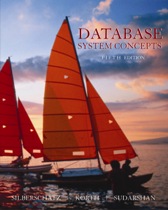The following syllabus is designed for a two semester sequence.
The first semester covers database design and modeling concepts,
while the second semester concentrates on implementation techniques.
![]()
Semester 1: Database Design and Modeling
- Chapter 1: Introduction
- Chapter 2: Relational Model
- Chapter 3: SQL
- Chapter 4: Advanced SQL
Sections 4.6 onwards may be omitted. - Chapter 5: Other Relational Languages
Sections 5.1 (Tuple Relational Calculus), 5.2 (Domain Relational Calculus), 5.3 (QBE) and Section 5.4 (Datalog) may be covered very briefly, to give an introduction to students. - Chapter 6: Entity-Relationship Model
- Chapter 7: Relational Database Design
- Appendix C: Advanced Relational Database Design
This appendix may be used as supplementary material. - Chapter 8: Application Design and Development
- Chapter 9: Object-Based Databases (may be omitted if desired)
- Chapter 10: XML
Section 10.4.3 (XSLT) may be omitted - Chapter 18: Data Analysis and Mining
- Chapter 19: Information Retrieval
- Assignments/Project
The course should be supplemented by assignments covering database design for a realistic application, and its implementation using SQL on a relational database systemThe project could involve the design of a schema for a realistic application, and the implementation of the entire application using SQL and other development tools such as Java servlets or JSP/ASP/ColdFusion/etc. See Chapter 8 for some sample projects.
Semester 2: Database System Implementation
- Chapter 11: Storage and File Structure
- Chapter 12: Indexing and Hashing
- Chapter 13: Query Processing
- Chapter 14: Query Optimization
- Chapter 15: Transactions
- Chapter 16: Concurrency Control
- Chapter 17: Recovery System
- Chapter 20: Database System Architectures
- Chapter 21: Distributed Databases
- Chapter 22: Parallel Databases
- Chapter 23: Advanced Application Development
- Miscellaneous
A selection of topics from Chapter 24(Advanced Data Types and New Applications), and Chapter 24 (Advanced Transaction Processing) could be covered, perhaps by student presentations, towards the end of the course. - Assignments/Project
The course should be supplemented by assignments involving the implementation of components of a relational database system.We recommend projects based on adding functionality to the PostgreSQL open-source database system. Examples of such projects include: adding SQL features that are currently not supported by PostgreSQL, implementing execution algorithms for specialized tasks such as finding top-K results, joins with external data sources, and so on. Chapter 26 provides an overview of PostgreSQL that students should read before studying the PostgreSQL code.
Another kind of project would require students to construct a relation manager on top of a storage manager such as Exodus. The relation manager should support relation scans with and without primitive predicates (= value, < value, > value). The students could then implement some relational algebra operations, such as joins, top of the relation manager. We recommend the interfaces, such as the relation manager interface, be defined by the instructor.
Implementing a concurrency control manager may be an alternative to or a supplement to implementing relational algebra operations.A more extensive project would be along the lines of the project used in the undergraduate database course in Wisconsin, where students implement not only the layers described above, but also implement a primitive file systems (page files), a primitive collection manager (heap files), and a buffer manager. Thereby students get a feel for all levels of a database system implementation. As before, all interfaces are defined by the instructor. The software system used in the Wisconsin projects is called Minibase.
Last updated April 2005.
 Database System Concepts
Database System Concepts